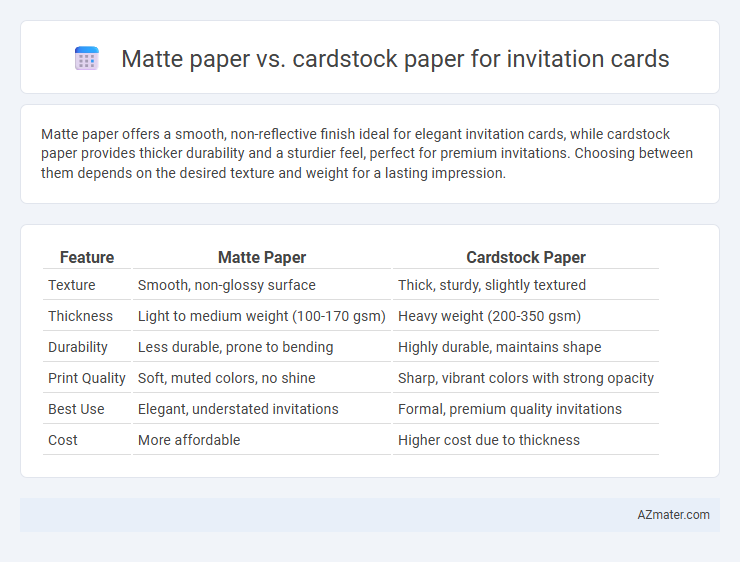Matte paper offers a smooth, non-reflective finish ideal for elegant invitation cards, while cardstock paper provides thicker durability and a sturdier feel, perfect for premium invitations. Choosing between them depends on the desired texture and weight for a lasting impression.
Table of Comparison
| Feature | Matte Paper | Cardstock Paper |
|---|---|---|
| Texture | Smooth, non-glossy surface | Thick, sturdy, slightly textured |
| Thickness | Light to medium weight (100-170 gsm) | Heavy weight (200-350 gsm) |
| Durability | Less durable, prone to bending | Highly durable, maintains shape |
| Print Quality | Soft, muted colors, no shine | Sharp, vibrant colors with strong opacity |
| Best Use | Elegant, understated invitations | Formal, premium quality invitations |
| Cost | More affordable | Higher cost due to thickness |
Understanding Matte Paper and Cardstock Paper
Matte paper features a smooth, non-reflective finish that enhances readability and provides a sophisticated, understated look, making it ideal for elegant invitation cards. Cardstock paper is thicker and sturdier than standard paper, offering durability and a premium feel that is perfect for formal invitations requiring longevity and a tactile impression. Choosing between matte paper and cardstock paper depends on the desired texture, weight, and visual impact for the invitation card design.
Key Differences between Matte and Cardstock Paper
Matte paper features a smooth, non-glossy finish that absorbs ink well, providing muted colors and a soft texture ideal for elegant invitation cards. Cardstock paper, typically thicker and sturdier, offers enhanced durability and a rigid feel, making it preferable for invitations requiring a premium, substantial presence. The key difference lies in matte paper's finish and lighter weight versus cardstock's thickness and structural strength, influencing both appearance and tactile impression.
Benefits of Using Matte Paper for Invitation Cards
Matte paper offers a smooth, non-reflective surface that enhances the legibility of printed text and enriches color depth, making invitation cards appear elegant and sophisticated. Its fingerprint-resistant quality ensures that invitations maintain a pristine look throughout handling and mailing. The subtle texture of matte paper complements various design styles, providing a refined, professional finish ideal for formal events.
Advantages of Choosing Cardstock Paper for Invitations
Cardstock paper offers superior durability and a premium feel, making invitation cards more resistant to bending and creasing compared to matte paper. Its thicker weight enhances the visual impact and provides a sturdy base for intricate designs and embellishments, ensuring invitations look polished and professional. The smooth surface of cardstock also allows for better ink adhesion and vibrant color reproduction, elevating the overall presentation of the invitation.
Texture and Finish: Matte vs. Cardstock
Matte paper offers a smooth, non-glossy finish that minimizes glare and provides a soft, elegant texture ideal for sophisticated invitation cards. Cardstock, known for its thicker and sturdier composition, delivers a more robust feel with a slightly rough or textured surface, enhancing the card's durability and tactile experience. Choosing between matte and cardstock depends on the desired invitation ambiance, with matte focusing on subtlety and sheen-free elegance, while cardstock emphasizes strength and a substantial hand-feel.
Durability and Thickness Comparison
Matte paper typically offers a smooth finish with moderate durability, making it resistant to fingerprints and smudges but less robust than cardstock. Cardstock paper is thicker and more rigid, providing superior durability and a premium feel for invitation cards that require sturdiness and long-lasting quality. The thickness of cardstock, often ranging from 80 lb to 110 lb, surpasses matte paper's usual weight, resulting in a more substantial and durable invitation.
Print Quality on Matte vs. Cardstock Paper
Matte paper offers a smooth, non-reflective finish that enhances print clarity and color vibrancy for invitation cards, making text and images crisp and easy to read. Cardstock paper, often thicker and sturdier, provides excellent durability while maintaining strong print quality, though its surface can sometimes cause slight color absorption differences compared to matte finishes. Choosing between matte and cardstock depends on the desired balance between print sharpness and invitation card rigidity.
Cost Considerations for Invitation Card Materials
Matte paper generally offers a more budget-friendly option for invitation cards compared to cardstock, making it ideal for large quantity orders. Cardstock paper is thicker and sturdier, resulting in a higher cost but providing a premium feel and enhanced durability. When balancing cost considerations, matte paper suits budget-conscious projects, while cardstock adds value through quality and tactile appeal.
Best Occasions for Matte or Cardstock Invitations
Matte paper offers a smooth, non-reflective finish ideal for elegant wedding invitations and formal events where readability and subtle sophistication are key. Cardstock paper provides a thicker, sturdier feel preferred for robust invitations like birthday parties, corporate events, and casual gatherings that require durability and impact. Choosing between matte and cardstock depends on the occasion's tone and the desired tactile experience for recipients.
How to Choose the Right Paper for Your Invitation Cards
Matte paper offers a smooth, non-reflective finish ideal for elegant, understated invitation cards, enhancing readability and soft color tones. Cardstock paper provides a thicker, more durable option that conveys luxury and sturdiness, perfect for keepsake invitations requiring a premium feel. Selecting the right paper depends on the desired texture, weight, and impression you want to create, balancing aesthetic appeal with functional durability.

Infographic: Matte paper vs Cardstock paper for Invitation card
 azmater.com
azmater.com